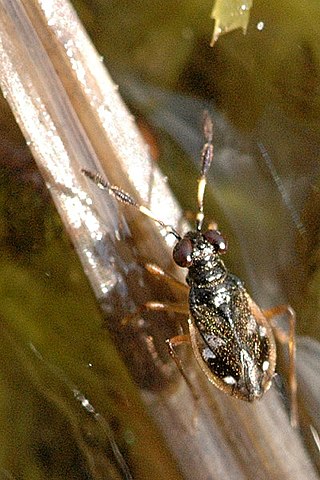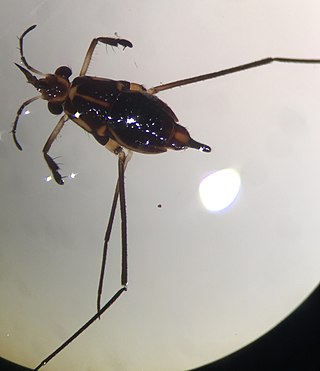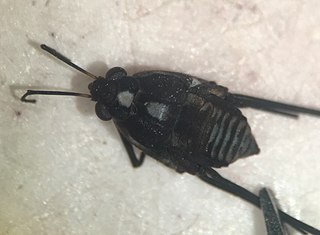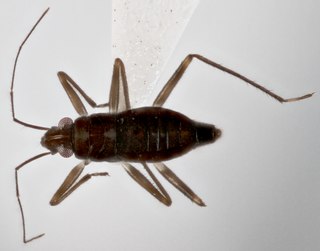
Ranatra is a genus of slender predatory insects of the family Nepidae, known as water scorpions or water stick-insects. There are around 100 Ranatra species found in freshwater habitats around the world, both in warm and temperate regions, with the highest diversity in South America and Asia. Fewer are found elsewhere, but include several African, some in North America, three from Australia and three from the Palearctic, notably the relatively well-known European R. linearis. Since Ranatra belongs to the family Nepidae which in turn belongs to the order Hemiptera, ranatrids are considered "true bugs".

Water treaders, the superfamily Mesovelioidea, are insects in the order Hemiptera, the true bugs. They are semiaquatic insects that live in moist and wet habitat and on wet plant matter in several types of aquatic habitat.

Gerris is a bug genus in the family Gerridae.
Mesovelia amoena is a species of water treader in the family Mesoveliidae. It is found in the Caribbean Sea, Central America, North America, Oceania, and South America.

Mesoveliidae is a family of water treaders in the order Hemiptera. There are about 16 genera and at least 50 described species in Mesoveliidae.

Saldoidini is a tribe of shore bugs in the family Saldidae. There are more than 20 genera and 250 described species in Saldoidini.

Rheumatobates is a genus of water striders in the family Gerridae. There are more than 30 described species in Rheumatobates.

Hesperocorixa is a genus of water boatmen in the family Corixidae. There are more than 20 described species in Hesperocorixa.

Merragata is a genus of velvet water bugs in the family Hebridae. There are about seven described species in Merragata.

Limnogonus is a genus of water striders in the family Gerridae. There are 28 described species in Limnogonus. Similar to other gerromorphan bugs, most species of Limnogonus have both macropterous specimens, which means that they are often able to fly. The wings are thought to be an adaptation to help the insects get away from drought allowing them to fly to the next available area that has water bodies when the rainy season arrives

Ochterus is a genus of velvety shore bugs in the family Ochteridae. There are more than 70 described species in Ochterus.

Metrobates is a genus of water striders in the family Gerridae. There are about 16 described species in Metrobates.
Platyvelia is a genus of smaller water striders in the family Veliidae. There are about nine described species in Platyvelia.

Leptopodidae is a family of spiny-legged bugs in the order Hemiptera. There are about 15 genera and more than 40 described species in Leptopodidae.

Mesovelia polhemusi is a species of water treader in the family Mesoveliidae. It was originally described from Belize and has since been found in southern Florida.













